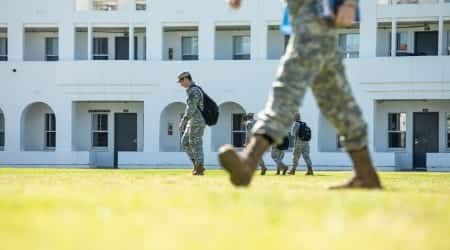
There was a time when acts of violence on U.S. school campuses were pretty much confined to an occasional after-school fistfight, a brief altercation between opposing teams on a football field or baseball diamond, bullies intimidating their smaller and more timid peers, a club initiation hazing incident gone awry, kids throwing rocks at each other or breaking windows, and the like.
However, that certainly hasn’t been the case in more recent decades when incidents of school violence have graduated to shootings, knife attacks, mob disorders, and other acts of deadly violence. What’s became abundantly clear to all in recent years was that campus safety must come first. Schools needed more safe and secure campuses in place in order to educate and prepare young people to be successful adults.
Add to the ongoing need to prevent campus violence the unprecedented COVID-19 pandemic earlier this year (2020) that, in addition to bringing worldwide commerce to an abrupt halt, closed school campuses, sending students either home or to off-campus remote learning venues. Schools have since implemented protocols designed to keep the virus from re-emerging once campuses re-open.
What some schools are doing about containing campus violence
Likewise, controlling campus violence is a top priority. To protect their school campuses against acts of violence and to be able to respond to those and other emergencies, many public school districts and private schools have equipped their campuses with military-grade high-tech security equipment and procedures, along with intensive training of teachers and other campus adults on what to do if an incident should break out
Other proven measures some schools have installed include metal detectors and security cameras which are intended to monitor or control students’ and visitors’ behaviors while on campus, according to a Fast Facts report from the National Center for Education Statistics. In fact, three years ago, 94 percent of public schools in the U.S. reported they had controlled access to school buildings by locking or monitoring doors and other entry points during school days.
Continuing, the report said: “Additionally, a great percentage of … primary and middle schools required students to wear uniforms … The percentage (70 percent) reported the enforcement of a strict dress code…” The report also said 62 percent of reporting high schools used “random dog sniffs” to check for drugs on students while on campus. A little more than 10 percent of reporting high schools were using random metal detector checks. A slightly higher number of high schools required students to wear badges or picture IDs.
Campus security begins with a plan
There are myriad sources of information schools can use to put together effective violence-prevention measures. But, as with most projects, planning how to prevent campus violence begins with just that, a plan. An article on campussafety.com refers to such a plan as a “safety audit.”
“Before we even look at any technological solutions, a (school) district should really look at its overall security threats and risks,” the article said. “A safety audit can help a school identify its weaknesses and come up with a plan to combat those issues.”
The audit should examine several key questions by asking school officials the following:
- How are you locking doors?
- Where are there line-of-sight issues?
- Is there a playground or athletic field that needs to be monitored?
- How do visitors enter the facility (campus)?
- How do people move about the facility (campus)? How do you keep control over that?
The end result of a safety audit is that a school can identify areas where there is a need for more security and now can begin to look at ways in which staff training or technology may help to respond to those needs.
A model campus security plan
Getting down to the specifics of what comprises an effective campus security plan, the Army and Navy Academy, a college preparatory boarding and day school for middle- and high-school age boys in Carlsbad, Calif. developed a comprehensive list of campus security measures after a thorough study of its oceanfront campus. Some of those measures and procedures include:
- State-of-the-art resources to train staff and students (hereafter referred to as Cadets) on issues that impact their physical and emotional welfare. Prior to beginning of each school year, Cadet leaders, faculty members, other staff members and volunteers who regularly come into contact with Cadets are trained how to watch for and immediately address any event or indication that might impact the physical or emotional safety of cadets.
- Within the overall training program, the Academy’s Security and Operations staff has undergone Federal Emergency Management Agency (FEMA) training and certification in school safety, earthquake and active assailant scenarios. The staff also undergoes monthly training in order to ensure compliance and to enhance staff members’ expertise.
- In addition, the Academy works with local, state, and federal agencies to integrate its emergency planning with those and other outside resources.
- The Academy’s closed-circuit TV system has cameras located at the five electronically controlled gates that control campus access; at locations along the campus perimeter as well as outside the cadet barracks and at other key locations on campus. Cameras are in operation and are monitored 24 hours a day, seven days a week by a security team of trained professionals whose sole focus is the safety of cadets and other Academy personnel.
- Bollards (steel posts) are in place to limit and control vehicle access to areas where there is extensive pedestrian activity and where Cadets reside.
- A badge and ID system tracks staff access to the campus via an automated electronic gate control system.
- The campus Operations Office is strategically sited near the main gate of the campus; the most-used access and exit for Cadets and others.
- The Academy’s Emergency Procedures Guide is in an easy-to-access flip chart format with copies located throughout the campus. Updated annually, the guide is used to train Academy staff members on how to respond to different kinds of emergencies.The Academy’s safety and security measures and procedures are reviewed and assessed on a regular basis by the local police department and an independent security consulting firm.’
- Fire safety is enhanced through annual campus inspects by the local city fire department with fire safety drills conducted regularly.
- The Academy has been working with local area schools to create a cross-collaboration and information-sharing group to identify common issues facing the participating schools.
Are schools safer now?
An April 2018 article in Education Week referenced a federal report released the prior month that said U.S. schools in recent years have “significantly increased” security measures and preparations for acts of violence. At the same time, rates of student victimization on school campuses have declined while fewer students have tried to bring weapons to school or have expressed fear of being harmed while at school.
That said, the report prompted cautious optimism from the U.S. Secretary of Education Betsy DeVos who said in a written statement: “While there are positive trends from the … report on crime and school safety, we know there is more we must do.”
